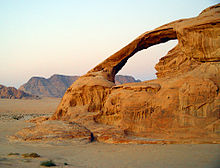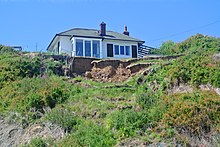Erosion

Erosion is the action of surface processes (such as
Agents of erosion include
While erosion is a natural process, human activities have increased by 10–40 times the rate at which

Physical processes
Rainfall and surface runoff
Rainfall, and the surface runoff which may result from rainfall, produces four main types of soil erosion: splash erosion, sheet erosion, rill erosion, and gully erosion. Splash erosion is generally seen as the first and least severe stage in the soil erosion process, which is followed by sheet erosion, then rill erosion and finally gully erosion (the most severe of the four).[10]: 60–61 [13]
In splash erosion, the impact of a falling raindrop creates a small crater in the soil,[14] ejecting soil particles.[4] The distance these soil particles travel can be as much as 0.6 m (2.0 ft) vertically and 1.5 m (4.9 ft) horizontally on level ground.
If the soil is saturated, or if the rainfall rate is greater than the rate at which water can infiltrate into the soil, surface runoff occurs. If the runoff has sufficient flow energy, it will transport loosened soil particles (sediment) down the slope.[15] Sheet erosion is the transport of loosened soil particles by overland flow.[15]

Extreme gully erosion can progress to formation of badlands. These form under conditions of high relief on easily eroded bedrock in climates favorable to erosion. Conditions or disturbances that limit the growth of protective vegetation (rhexistasy) are a key element of badland formation.[21]
Rivers and streams

Valley or stream erosion occurs with continued water flow along a
Bank erosion is the wearing away of the banks of a stream or river. This is distinguished from changes on the bed of the watercourse, which is referred to as scour. Erosion and changes in the form of river banks may be measured by inserting metal rods into the bank and marking the position of the bank surface along the rods at different times.[23]
Thermal erosion is the result of melting and weakening
Most river erosion happens nearer to the mouth of a river. On a river bend, the longest least sharp side has slower moving water. Here deposits build up. On the narrowest sharpest side of the bend, there is faster moving water so this side tends to erode away mostly.
Rapid erosion by a large river can remove enough sediments to produce a
Coastal erosion

Shoreline erosion, which occurs on both exposed and sheltered coasts, primarily occurs through the action of currents and
Hydraulic action takes place when the air in a joint is suddenly compressed by a wave closing the entrance of the joint. This then cracks it. Wave pounding is when the sheer energy of the wave hitting the cliff or rock breaks pieces off. Abrasion or corrasion is caused by waves launching sea load at the cliff. It is the most effective and rapid form of shoreline erosion (not to be confused with corrosion). Corrosion is the dissolving of rock by carbonic acid in sea water.[28] Limestone cliffs are particularly vulnerable to this kind of erosion. Attrition is where particles/sea load carried by the waves are worn down as they hit each other and the cliffs. This then makes the material easier to wash away. The material ends up as shingle and sand. Another significant source of erosion, particularly on carbonate coastlines, is boring, scraping and grinding of organisms, a process termed bioerosion.[29]
Sediment is transported along the coast in the direction of the prevailing current (longshore drift). When the upcurrent supply of sediment is less than the amount being carried away, erosion occurs. When the upcurrent amount of sediment is greater, sand or gravel banks will tend to form as a result of deposition. These banks may slowly migrate along the coast in the direction of the longshore drift, alternately protecting and exposing parts of the coastline. Where there is a bend in the coastline, quite often a buildup of eroded material occurs forming a long narrow bank (a spit). Armoured beaches and submerged offshore sandbanks may also protect parts of a coastline from erosion. Over the years, as the shoals gradually shift, the erosion may be redirected to attack different parts of the shore.[30]
Erosion of a coastal surface, followed by a fall in sea level, can produce a distinctive landform called a raised beach.[31]
Chemical erosion
Chemical erosion is the loss of matter in a landscape in the form of
Formation of sinkholes and other features of karst topography is an example of extreme chemical erosion.[33]
Glaciers

Glaciers can also cause pieces of bedrock to crack off in the process of plucking. In ice thrusting, the glacier freezes to its bed, then as it surges forward, it moves large sheets of frozen sediment at the base along with the glacier. This method produced some of the many thousands of lake basins that dot the edge of the
These processes, combined with erosion and transport by the water network beneath the glacier, leave behind glacial landforms such as moraines, drumlins, ground moraine (till), glaciokarst, kames, kame deltas, moulins, and glacial erratics in their wake, typically at the terminus or during glacier retreat.[41]
The best-developed glacial valley morphology appears to be restricted to landscapes with low rock uplift rates (less than or equal to 2mm per year) and high relief, leading to long-turnover times. Where rock uplift rates exceed 2mm per year, glacial valley morphology has generally been significantly modified in postglacial time. Interplay of glacial erosion and tectonic forcing governs the morphologic impact of glaciations on active orogens, by both influencing their height, and by altering the patterns of erosion during subsequent glacial periods via a link between rock uplift and valley cross-sectional shape.[42]
Floods

At extremely high flows,
Wind erosion

Wind erosion is a major
Wind erosion is of two primary varieties: deflation, where the wind picks up and carries away loose particles; and abrasion, where surfaces are worn down as they are struck by airborne particles carried by wind. Deflation is divided into three categories: (1) surface creep, where larger, heavier particles slide or roll along the ground; (2) saltation, where particles are lifted a short height into the air, and bounce and saltate across the surface of the soil; and (3) suspension, where very small and light particles are lifted into the air by the wind, and are often carried for long distances. Saltation is responsible for the majority (50–70%) of wind erosion, followed by suspension (30–40%), and then surface creep (5–25%).[46]: 57 [47]
Wind erosion is much more severe in arid areas and during times of drought. For example, in the Great Plains, it is estimated that soil loss due to wind erosion can be as much as 6100 times greater in drought years than in wet years.[48]
Mass wasting

Mass wasting or mass movement is the downward and outward movement of rock and sediments on a sloped surface, mainly due to the force of gravity.[49][50]
Mass wasting is an important part of the erosional process and is often the first stage in the breakdown and transport of weathered materials in mountainous areas.[51]: 93 It moves material from higher elevations to lower elevations where other eroding agents such as streams and glaciers can then pick up the material and move it to even lower elevations. Mass-wasting processes are always occurring continuously on all slopes; some mass-wasting processes act very slowly; others occur very suddenly, often with disastrous results. Any perceptible down-slope movement of rock or sediment is often referred to in general terms as a landslide. However, landslides can be classified in a much more detailed way that reflects the mechanisms responsible for the movement and the velocity at which the movement occurs. One of the visible topographical manifestations of a very slow form of such activity is a scree slope.[citation needed]
Slumping happens on steep hillsides, occurring along distinct fracture zones, often within materials like clay that, once released, may move quite rapidly downhill. They will often show a spoon-shaped isostatic depression, in which the material has begun to slide downhill. In some cases, the slump is caused by water beneath the slope weakening it. In many cases it is simply the result of poor engineering along highways where it is a regular occurrence.[52]
Surface creep is the slow movement of soil and rock debris by gravity which is usually not perceptible except through extended observation. However, the term can also describe the rolling of dislodged soil particles 0.5 to 1.0 mm (0.02 to 0.04 in) in diameter by wind along the soil surface.[53]
Submarine sediment gravity flows
On the
Factors affecting erosion rates
| Part of a series on |
| Geology |
|---|
 |
Climate
The amount and intensity of
In some areas of the world (e.g. the
In other regions of the world (e.g. western Europe), runoff and erosion result from relatively low intensities of stratiform rainfall falling onto the previously saturated soil. In such situations, rainfall amount rather than intensity is the main factor determining the severity of soil erosion by water.[17] According to the climate change projections, erosivity will increase significantly in Europe and soil erosion may increase by 13–22.5% by 2050 [62]
In Taiwan, where typhoon frequency increased significantly in the 21st century, a strong link has been drawn between the increase in storm frequency with an increase in sediment load in rivers and reservoirs, highlighting the impacts climate change can have on erosion.[63]
Vegetative cover
Vegetation acts as an interface between the atmosphere and the soil. It increases the
Topography
The topography of the land determines the velocity at which surface runoff will flow, which in turn determines the erosivity of the runoff. Longer, steeper slopes (especially those without adequate vegetative cover) are more susceptible to very high rates of erosion during heavy rains than shorter, less steep slopes. Steeper terrain is also more prone to mudslides, landslides, and other forms of gravitational erosion processes.[61]: 28–30 [66][67]
Tectonics
Tectonic processes control rates and distributions of erosion at the Earth's surface. If the tectonic action causes part of the Earth's surface (e.g., a mountain range) to be raised or lowered relative to surrounding areas, this must necessarily change the gradient of the land surface. Because erosion rates are almost always sensitive to the local slope (see above), this will change the rates of erosion in the uplifted area. Active tectonics also brings fresh, unweathered rock towards the surface, where it is exposed to the action of erosion.
However, erosion can also affect tectonic processes. The removal by erosion of large amounts of rock from a particular region, and its deposition elsewhere, can result in a lightening of the load on the
Development
Human land development, in forms including agricultural and urban development, is considered a significant factor in erosion and
Erosion at various scales
Mountain ranges
Examples of heavily eroded mountain ranges include the Timanides of Northern Russia. Erosion of this orogen has produced sediments that are now found in the East European Platform, including the Cambrian Sablya Formation near Lake Ladoga. Studies of these sediments indicate that it is likely that the erosion of the orogen began in the Cambrian and then intensified in the Ordovician.[75]
Soils
If the rate of erosion is higher than the rate of soil formation the soils are being destroyed by erosion.[76] Where soil is not destroyed by erosion, erosion can in some cases prevent the formation of soil features that form slowly. Inceptisols are common soils that form in areas of fast erosion.[77]
While erosion of soils is a natural process, human activities have increased by 10-40 times the rate at which erosion is occurring globally. Excessive (or accelerated) erosion causes both "on-site" and "off-site" problems. On-site impacts include decreases in
In the United States, farmers cultivating highly erodible land must comply with a conservation plan to be eligible for certain forms of agricultural assistance.[79]
Consequences of human-made soil erosion
See also
- Bridge scour – Erosion of sediment near bridge foundations by water
- Cellular confinement – Confinement system used in construction and geotechnical engineering
- Colluvium – Loose, unconsolidated sediments deposited at the base of a hillslope
- Groundwater sapping
- Lessivage
- Space weathering – Type of weathering
- TERON (Tillage erosion)
- Vetiver System – System of soil and water conservation
References
- ^ a b "Erosion". Encyclopædia Britannica. 2015-12-03. Archived from the original on 2015-12-21. Retrieved 2015-12-06.
- ISBN 9780199653065.
- S2CID 130966449.
- ^ S2CID 13077807.[permanent dead link]
- ISSN 0260-3055.
- (PDF) from the original on 2016-10-11. Retrieved 2016-06-18.
- S2CID 129797403.
- doi:10.1130/g36272.1.
- ISBN 978-1-4020-8709-7.
- ^ ISBN 978-0-471-38369-7.
- ISSN 2071-1050.)
{{cite journal}}: CS1 maint: multiple names: authors list (link - ISBN 978-0-521-53737-7.
- ISBN 978-0-444-99725-8.
- S2CID 59437729.
- ^ ISBN 978-92-5-100474-6.
- .
- ^ ISBN 978-0-470-85911-7.
- ISBN 978-0-471-49123-1.
- ISBN 978-0-7844-0814-8.
- S2CID 234800558.
- ISBN 9780128130544.
- OCLC 79006225
- ISBN 978-0-470-84357-4.
- ^ "Thermal Erosion". NSIDC Glossary. National Snow and Ice Data Center. Archived from the original on 2010-12-18. Retrieved 21 December 2009.
- S2CID 131318239.
- hdl:10535/5534. Archived from the originalon 2013-05-17.
- .
- ^ Geddes, Ian. "Lithosphere". Higher geography for cfe: physical and human environments, Hodder Education, 2015.
- ^ Glynn, Peter W. "Bioerosion and coral-reef growth: a dynamic balance". Life and death of coral reefs (1997): 68–95.
- ^ Bell, Frederic Gladstone. "Marine action and control". Geological hazards: their assessment, avoidance, and mitigation, Taylor & Francis, 1999, pp. 302–306.
- ^ Pinter, N (2010). "Exercise 6 - Coastal Terraces, Sealevel, and Active Tectonics" (PDF). Archived from the original (PDF) on 2010-10-10. Retrieved 2011-04-21.
- .
- doi:10.1130/0091-7613(1995)023<0949:GOASSW>2.3.CO;2.)
{{cite journal}}: CS1 maint: multiple names: authors list (link - ^ "The Devil's Nest, the deepest ground erosion in Europe".
- S2CID 4273817.
- S2CID 205217746.
- ^ S2CID 205222252.
- (PDF) from the original on 2017-08-09. Retrieved 2017-10-24.
- ^ Mitchell, S.G. & Montgomery, D.R. "Influence of a glacial buzzsaw on the height and morphology of the Cascade Range in central Washington State". Quat. Res. 65, 96–107 (2006)
- doi:10.1038/ngeo2524.
- ^ Harvey, A.M. "Local-Scale geomorphology – process systems and landforms". Introducing Geomorphology: A Guide to Landforms and Processes. Dunedin Academic Press, 2012, pp. 87–88. EBSCOhost.
- (PDF) from the original on Apr 16, 2024 – via PMC.
- ISBN 978-0-87842-415-3.
- ISBN 978-3-540-88253-4.
- ISBN 978-1-4020-4261-4.
- ISBN 978-1-4020-8709-7.
- ISBN 978-0-87371-811-0.
- ISBN 978-0-470-71076-0.
- ISBN 978-1-4020-6675-7.
- ISBN 978-0-471-04978-4.
- ^ ISBN 978-1-4051-9379-5.
- ISBN 978-81-89422-28-8.
- ^ "Britannica Library". library.eb.com. Retrieved 2017-01-31.
- S2CID 134740576.
- .
- S2CID 134823668.
- ISBN 9780128149607.
- S2CID 251576822.
- S2CID 213281574.
- ISBN 978-90-481-8699-0.
- ^ ISBN 978-1-4020-8709-7.
- ISSN 1462-9011.
- ^ from the original on 2017-02-24. Retrieved 2017-02-23.
- S2CID 55243167.
- ISBN 978-0-419-15630-7.
- ISBN 978-0-521-04983-2.
- ISBN 978-0-470-71076-0.
- ISBN 978-1-4443-4504-9.
- ^ Zeitler, P.K. et al. (2001), Erosion, Himalayan Geodynamics, and the Geomorphology of Metamorphism, GSA Today, 11, 4–9.
- .
- ISBN 0-19-823252-7.
- ISSN 0148-0227.
- ^ Beckinsale, Robert P.; Chorley, Richard J. (2003) [1991]. "Chapter Seven: American Polycyclic Geomorphology". The History of the Study of Landforms. Vol. Three. Taylor & Francis e-Library. pp. 235–236.
- S2CID 55985869.
- S2CID 128973374. Retrieved 22 September 2015.
- ^ Lupia-Palmieri, Elvidio (2004). "Erosion". In Goudie, A.S. (ed.). Encyclopedia of Geomorphology. p. 336.
- ISBN 978-1-4665-9436-4.
- ISBN 978-90-481-8529-0.
- ^ "Farm and Commodity Policy: Glossary". United States Department of Agriculture. Archived from the original on 2 September 2011. Retrieved 17 July 2011.
Further reading
- Boardman, John; Poesen, Jean, eds. (2007). Soil Erosion in Europe. Chichester: John Wiley & Sons. ISBN 978-0-470-85911-7.
- Montgomery, David (2008). Dirt: The Erosion of Civilizations (1st ed.). University of California Press. ISBN 978-0-520-25806-8.
- Montgomery, D.R. (8 August 2007). "Soil erosion and agricultural sustainability". Proceedings of the National Academy of Sciences. 104 (33): 13268–13272. PMID 17686990.
- Vanoni, Vito A., ed. (1975). "The nature of sedimentation problems". Sedimentation Engineering. ASCE Publications. ISBN 978-0-7844-0823-0.
- Mainguet, Monique; Dumay, Frédéric (April 2011). Fighting wind erosion. One aspect of the combat against desertification. Les dossiers thématiques du CSFD. CSFD/Agropolis International. Archived from the original on 30 December 2020. Retrieved 7 October 2015.
